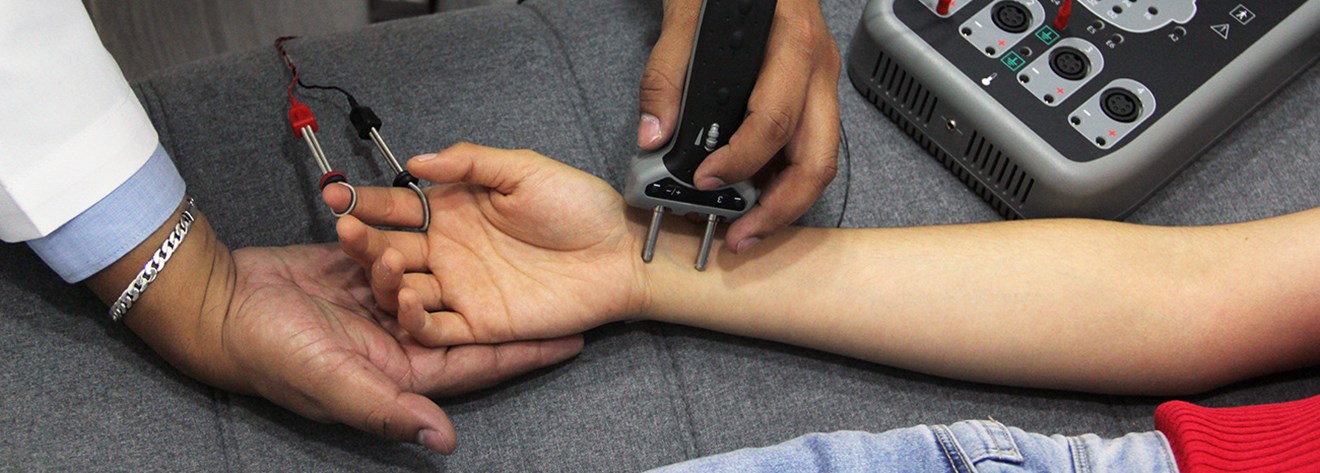Needle Muscle Biopsy
My needle muscle biopsies are performed at King's College Hospital, Denmark Hill, London, SE5 9RS.
Purpose
To obtain muscle tissue specimen for diagnostic study. The precise reasons for the muscle biopsy in your case will be explained to you by me.
Preparation
A nurse will bring you into the procedure room and the following procedure will be explained. The doctor performing the biopsy will outline the risks of the procedure and answer any questions that you may have. You will then be asked to sign the consent form.
Procedure
You will be asked to lie on your back on an examination couch for the duration of the procedure which lasts approximately 15 minutes. The sample is taken from the quadriceps muscle (your upper leg), most from the left side but occasionally from the right side. The area is cleansed with antiseptic and then covered with a sterile drape. Local anaesthetic (2% lignocaine) is then injected into the skin and then deeper into the muscle. This may produce a temporary stinging sensation. Five minutes is allowed for the area to become numb. The doctor will then make a small ¼" incision and insert a small hollow biopsy tube to take the specimen. You should not feel any pain, however a little suction is applied that may cause some pressure. After adequate specimens are obtained (which may take up to 4 attempts through the same incision) the incision is closed with steri-strips and then covered with a transparent adhesive dressing. No stitches are required.
Possible Complications
These are rare but include infection and bleeding. Occasionally it may not be possible to get an adequate sample of muscle despite our best efforts. If this proves to be the case it may be necessary to repeat the procedure as an open muscle biopsy. This would occur at a future date and after discussion with me.
Post-procedure care
KEEP THE BIOPSY SITE DRY FOR 7 DAYS. When showering, tape a piece of plastic around the region. This is to prevent infection in the open wound.
You can walk around but avoid strenuous activity for the next 7 days.
The site of the biopsy may ache for a day once the local anaesthetic has worn off. It may feel like you have bumped into the edge of a table. You can take ibuprofen or paracetamol for the pain but please do not take high dose aspirin as this thins the blood and may cause bleeding. (If you are on low dose aspirin anyway then please continue to take it).
It is all right if there is small amount of blood at the site. However, if there is a lot of bleeding, swelling, redness or other complications, please call your GP.
You can remove the steri-strips and dressings in 7 days.
Muscle Biopsy: Storage, analysis and results
What happens to the muscle samples?
The muscle samples are specially frozen so that they can be properly analysed. The frozen muscle samples are sliced into very thin sections, mounted on glass slides and treated with special stains that allow us to visualise various aspects of the muscle structure (histological stains). Other staining techniques allow us to visualise some of the biochemical functions of the muscle (histocytochemistry). Sometimes electronmicroscopy is used to allow us to see muscle structure at very high magnification. These tests are done to diagnose your muscle condition.
Many of the analytical techniques are performed in the pathology laboratories at King's College Hospital. Occasionally it is helpful to send some of the muscle sample to other laboratories in this country, or abroad for more specialist biochemical analysis in order to diagnose your muscle condition. We need your permission to send muscle samples to other laboratories for this biochemical analysis.
As well as analysing the structure and biochemistry of the muscle samples we can also perform genetic tests on the muscle samples in order to help diagnose your muscle condition. Genetic studies are done in various laboratories in this country and abroad. Again, we need your permission to send muscle samples to other laboratories for this genetic testing.
Freezing your muscle biopsy samples also allows us to store the samples for future analysis. If no relevant biochemical or genetic test is currently available to diagnose your condition, the sample will be stored until such time that an appropriate test is developed.
It may be very helpful to use your stored muscle sample anonymously for research purposes. Such research may include the development and standardisation of new tests or basic science research to better understand muscle diseases. You may not personally benefit from such research but it may benefit others with muscle disease.
It may also be helpful to use, anonymously, pictures of your muscle slides for educational purposes such as lectures and teaching sessions to medical audiences. We need your permission before we can use any of your stored muscle samples for such educational purposes.
When do I get my results?
The basic histochemical and histocytochemical stains are ready to analyse within one week of the biopsy. I attend the meeting with the muscle pathologists at which we look at muscle biopsy results, discuss the findings and agree the diagnosis or other tests needed to make the diagnosis. The formal agreed report on the biopsy is then available 2 weeks after the biopsy. You should check with my secretary that the report is available before arranging an appointment to discuss the biopsy results after 2 weeks. If more detailed studies are required these may take several weeks to complete and then a supplementary report will be issued.
If you have questions about the procedure contact;
Dr Rose's King's College Hospital secretary; 020 3299 8343
Please do not use this number to ask for results as these must be given to you by me.
